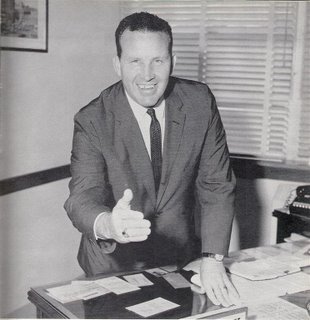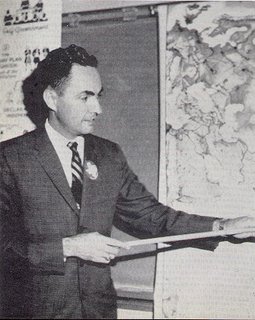
Would you have bought a used car from this man? Some of us would have taken whatever he might have offered under advisement in order to reserve judgment. I always thought this “trust me” picture pretty well illustrated Mr. Roy C. Johnson as some of us saw him.
Roy C. Johnson was the school’s first principal, so he had the job during the time the 63 Highlanders were assigned to the institution. Mr. Johnson had an expansive persona, a down-home Texan manner, and was an enthusiastic cheerleader at pep rallies. His daughter was a year younger than we were—a 64 Highlander. As I recall, she was considered by others to be a nice young lady, although I didn’t know her.
Some in our class didn’t care too much for Mr. Johnson. And even now I couldn’t articulate very well why that was so. Some thought that he was highly ambitious for a higher level district job and might have been a little too aggressive in his self promotion. One manifestation of that notion was that he hung a large, formal portrait of himself in the school’s front entry foyer. Flanking his large portrait, evenly spaced on either side were somewhat smaller (I think) portraits of the school board members, including the Superintendent. That might have been the job Mr. Johnson really wanted.
Someone took his portrait down one day, leaving the school board portraits undisturbed. For several days the portrait was missing and it was said that Mr. Johnson went ballistic when he made the discovery. The image of Captain Queeg’s search for the strawberries dances through my mind. It was also said that Mr. Johnson had some “spies” among our class, but a lot of people knew who the spies were, so they weren’t much of a threat. Within a day or so, Mr. Johnson had all the other portraits taken down—thinking, I suppose, that if he couldn’t hang there, then by-golly no one else would hang there either!
After some time went by, Mr. Johnson’s portrait was returned to its place of honor in the front foyer, right in the center of a row of empty picture hangers spaced equally either side of it. However, that portrait was a bit different than it had been before its hiatus in service as a revered school treasure. Mr. Johnson’s image was inverted inside the frame. So, just turn it over, you might suggest. O.K., but first you would have to remove the youthful manifesto sheet that had been inserted in the frame, just in front of Mr. Johnson’s image. So, just take it apart and remove the sheet, you might suggest. O.K., but how would you suggest freeing up the super glue that held the mat assembly to both the glass and the frame?
I don’t recall if those portraits were re-hung in the front foyer before we graduated. However, I do seem to recall a certain probing look in Mr. Johnson’s eye as he extended his congratulatory hand to each us at our graduation ceremony. Danny McCoy always called Mr. Johnson, "Sugarbottom" and I never knew where that came from--just found it amusing.
Someone took his portrait down one day, leaving the school board portraits undisturbed. For several days the portrait was missing and it was said that Mr. Johnson went ballistic when he made the discovery. The image of Captain Queeg’s search for the strawberries dances through my mind. It was also said that Mr. Johnson had some “spies” among our class, but a lot of people knew who the spies were, so they weren’t much of a threat. Within a day or so, Mr. Johnson had all the other portraits taken down—thinking, I suppose, that if he couldn’t hang there, then by-golly no one else would hang there either!
After some time went by, Mr. Johnson’s portrait was returned to its place of honor in the front foyer, right in the center of a row of empty picture hangers spaced equally either side of it. However, that portrait was a bit different than it had been before its hiatus in service as a revered school treasure. Mr. Johnson’s image was inverted inside the frame. So, just turn it over, you might suggest. O.K., but first you would have to remove the youthful manifesto sheet that had been inserted in the frame, just in front of Mr. Johnson’s image. So, just take it apart and remove the sheet, you might suggest. O.K., but how would you suggest freeing up the super glue that held the mat assembly to both the glass and the frame?
I don’t recall if those portraits were re-hung in the front foyer before we graduated. However, I do seem to recall a certain probing look in Mr. Johnson’s eye as he extended his congratulatory hand to each us at our graduation ceremony. Danny McCoy always called Mr. Johnson, "Sugarbottom" and I never knew where that came from--just found it amusing.
Just ahead for some of us was Animal House.

(May 2014 note: Discovered some time ago that "Sugarbottom" was the name of a very small town or area in North Texas somewhere, where Mr. Johnson grew up. It hasn't existed for many years.)
Adios.

























